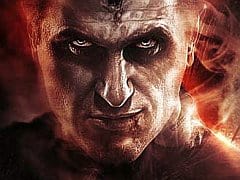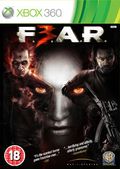You can trust VideoGamer. Our team of gaming experts spend hours testing and reviewing the latest games, to ensure you're reading the most comprehensive guide possible. Rest assured, all imagery and advice is unique and original. Check out how we test and review games here
It’s 2011, and FEAR 3 is relying on the same scare tactics that the original game did back in 2005. Shadows of ominous-looking creatures flit about your peripheral vision, harrowing screams ring out from an unknown source, and every now and again Alma – the disturbing little girl at the heart of the game’s narrative – will appear out of nowhere, just standing there, looking all weird and unearthly. Whilst this can on rare occasions be a little jumpy, it’s never remotely scary.
There are several explanations for this: firstly, the game’s protagonist, the absurdly-named Point Man, never seems all too concerned about the hell that’s unfolding around him. Silent protagonists are fine – just ask Link or Gordon Freeman (not that they’d respond) – but in a horror game they remove a much needed element of humanity from the narrative. Co-op play offers no remedy for this either, as it’s hard to be scared with a chum on the other end of a headset. More than this, though, it’s simply that we’ve seen it all before; we’ve become desensitised to the horror. This is a sentiment that’s been echoed in the VideoGamer community recently.
What is truly frightening, though, is the script writers’ inability to weave a coherent story. It’s hard to be scared by something so hard to comprehend, after all. Even the talents of John Carpenter (Halloween, The Thing) fail to save the narrative from the convoluted mess that FEAR 3 descends into.
Nine months after the events of FEAR 2, Paxton Fettel breaks his brother, Point Man, out of a high security prison. The pair embark on a quest to reunite with their pregnant mother, Alma, who is still wreaking paranormal havoc on the town of Fairport. While they’re happy to collaborate towards this end goal, the pair have very different reasons for making the journey.
Over the course of the game we’re told an increasingly complex tale of child abuse, sibling rivalry and family reunion. It’s mostly a load of tosh, and requires a good memory of the previous games (and knowledge of the comics) to understand properly.
This doesn’t stop FEAR 3 from being a good game, though. Despite never making much sense, the narrative permits a rather interesting hook. As the game revolves around two brothers, two players can bro-up and play through the campaign together. While Point Man is happy to rely on his guns and the occasional burst of slow-motion – a staple ingredient of the FEAR recipe – Fettel prefers his telekinetic powers, in particular the ability to possess enemy soldiers. This is likely the reason two ‘friends’ will squabble for half an hour before allowing themselves to play the game – Fettel is a lot more interesting to play as.
Once in command of a biological vessel, Fettel can operate firearms much like his brother, but his powers can only sustain the body for so long. After his possession meter is depleted he’s booted back to ghost-town, with the expired body exploding into gory chunks. Collecting glowing orbs from the corpses of downed soldiers can extend the length of this voodoo, but Fettel is far from useless in his spectre state. As well as being able to hold enemies prisoner in the air and manipulate the environment, Fettel can also create a temporary shield for his brother – a buff, if you will.
Despite being a co-operative affair, FEAR 3 incites fierce rivalry with its scoring mechanic. As you progress through the game points are awarded according to the manner in which you dispatch of your enemies. Big rewards are on offer for meeting the requirements of specific challenges. This might be killing 50 enemies with a specific gun, nailing a certain number of headshots, or looting a set amount of ammo. This all ties into a rank system, with perks and bonuses for levelling up.
At the end of a stage the game will tot up all these points and choose a ‘favourite son’ based on the scores. So, while you’re working together to reach the end of a level, you’re also working against each other to beat your brother and earn Mummy’s (or is it Daddy’s?) approval.
Regardless of whether you’re playing with a chum or not, the gunplay remains solid throughout. Weapons are reassuringly chunky, and slow-motion violence remains incredibly satisfying, even six years after the original game. The Elite Power Armour from FEAR 2 also makes a return, splitting up everyday stretches of gameplay with explosive, infinite-rocket-laden mech scraps. Although the campaign is short, clocking in at just shy of seven hours, these sections ensure the game never gets dull or repetitive. It’s worth pointing out that completing a level also unlocks Fettel for single-player use, effectively doubling the length of the game if you’re up for playing as the other brother.
Multiplayer is split into four modes, without a team deathmatch or capture the flag in sight. Contractions is probably the most immediately recognisable of the bunch, throwing waves of enemies at the player, Nazi zombies-style. In between rounds you can rebuild barricades and run off to secure storage crates, which unlock bigger and better weapons for your stronghold.
Soul King and Soul Survivor are both influenced by Fettel’s possession trick – although instead of Fettel you’ll play as a floating spectre with mangled claws that hang limply in front of the camera. In Survivor, one of four players is chosen at random to be a spectre, who must then convert the other three to his ghostly cause. Jumping into the body of an NPC soldier, the spectre player must first riddle another player with bullets, then possess and convert them.
King is similar, except all four players assume the role of a spectre. The idea here is to score as many kills as possible whilst in a possessed form. The player with the most points becomes the King, and is highlighted on the map for all to see. Killing the King bags half their orbs, which can send a player from first to last place with little more than a well placed bullet.
Then there’s F**king Run, which probably has the longest legs of the four modes. And long legs you’ll need, as a towering wall of smoke pursues you relentlessly through Fairport. Standing in your way, however, are the game’s cast of soldiers, ghouls and zombies. Should they slow you down enough, and they inevitably will, this wall – with a horrible twisted face you can make out if you squint hard enough – will devour you whole. Beating the wall, and getting as far as possible through each level is arguably the highlight of the multiplayer.
FEAR 3 is an enjoyable experience. The gunplay is solid, the multiplayer components are interesting, and playing as Fettel puts a really neat spin on things. I can’t help thinking, in fact, that Fettel – with his telekinesis and ghost trickery – would have been a better focal point for the singleplayer and made it stand out more.
Ultimately, FEAR 3 is another game that’ll get lost in 2011 for being a bit forgettable. Maybe if it inspired loss of bladder control in the same way the original did – or, better still, how Monolith’s Condemned did – it might have been slightly more memorable. FEAR 3 is sadly lacking in the fear department, and has subsequently lost its defining characteristic.
F.3.A.R.
- Platform(s): PC, PlayStation 3, Xbox 360
- Genre(s): Action, First Person, Shooter

/https://oimg.videogamer.com/images/16f1/fear_3_17.jpg)
/https://oimg.videogamer.com/images/a9a4/fear_3_23.jpg)
/https://oimg.videogamer.com/images/92fc/fear_3_15.jpg)






